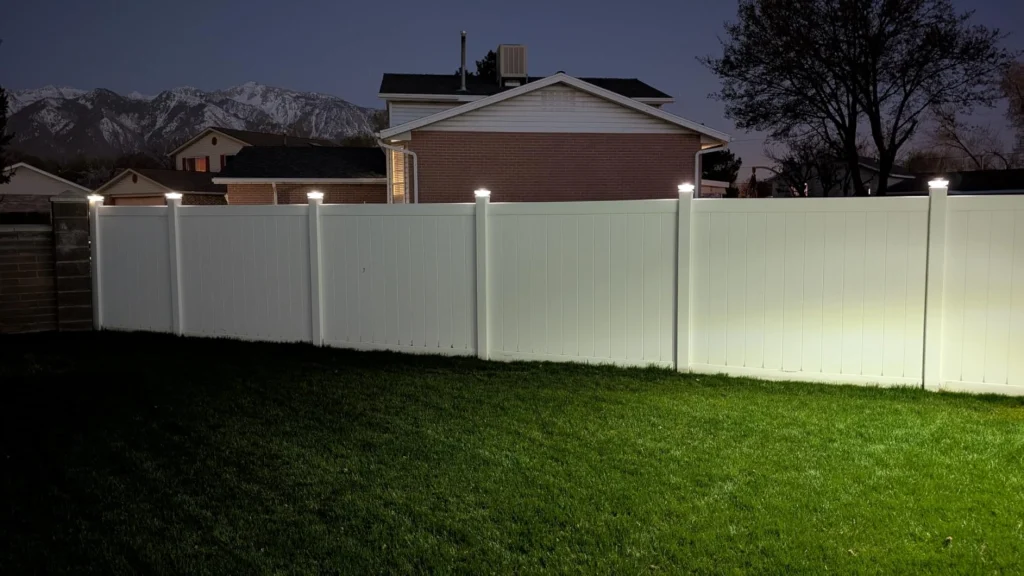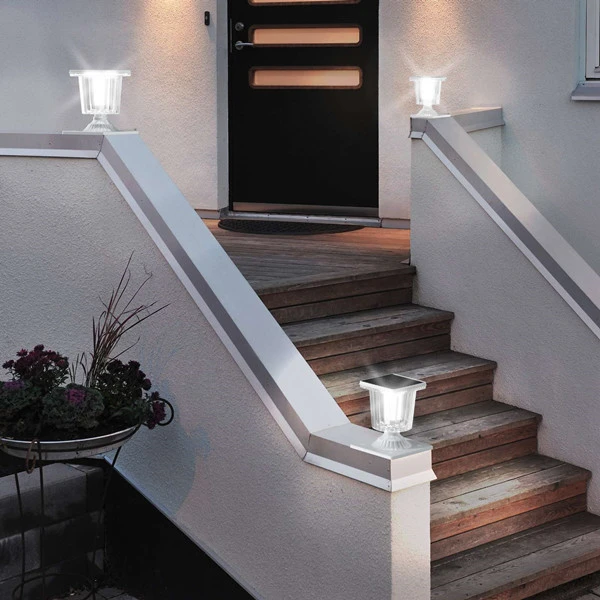In today’s world, ensuring the safety of your home is a top priority. One innovative and eco-friendly way to bolster home security is by installing solar fence post lights. These versatile fixtures not only illuminate pathways and outdoor spaces but also serve as an effective tool to deter intruders. By harnessing solar energy, they offer a cost-effective and sustainable alternative to traditional security lighting. This article explores how solar fence post lights enhance safety, provides a step-by-step installation guide, offers tips on the best placement, and compares their cost-effectiveness with conventional options.
How Solar Fence Post Lights Improve Home Security
Solar fence post lights are an excellent addition to any home security system. By strategically lighting up key areas, they eliminate dark spots where intruders might hide, making your property less appealing to potential threats. The soft glow of these lights can illuminate pathways, driveways, and garden areas, ensuring safe navigation for residents and guests at night. This increased visibility reduces the risk of accidents, such as tripping on uneven surfaces, while also enhancing the aesthetic appeal of your outdoor space.

Beyond their practical function, these lights play a significant role in deterring intruders. A well-lit property signals that the homeowner is vigilant, discouraging trespassers from attempting unauthorized entry. Many solar fence post lights come equipped with motion sensors, which activate the lights only when movement is detected. This feature not only conserves energy but also startles potential intruders, drawing attention to their presence. Studies suggest that well-lit properties are up to 20% less likely to be targeted by burglars, making solar fence post lights a powerful deterrent.
Additionally, because these lights operate on solar power, they function independently of your home’s electrical grid. This ensures that your home security remains intact during power outages, providing peace of mind in any situation. Their wireless design also eliminates the need for complex wiring, reducing vulnerabilities that could be exploited by cutting power lines.
Installation Guide for Solar Fence Post Lights
Installing solar fence post lights is a straightforward process that most homeowners can complete without professional assistance. Here’s a step-by-step installation guide to help you get started:
- Choose the Right Lights: Select solar fence post lights that match your fence post size (typically 4×4 or 5×5 inches) and have features like motion sensors or adjustable brightness. Ensure they have a high IP rating (e.g., IP65) for weather resistance.
- Gather Tools and Materials: You’ll need a screwdriver, drill (if screws are required), measuring tape, and the lights’ mounting hardware (usually included). Check that the solar panel is clean and free of debris.
- Plan Placement: Identify fence posts that receive ample sunlight during the day, as this ensures optimal charging. Avoid shaded areas under trees or overhangs. Refer to the best placement tips below for more details.
- Mount the Lights: Most solar fence post lights are designed to slide onto or clip over standard fence posts. Secure them using the provided screws or adhesive, ensuring a firm connection. For non-standard posts, you may need adapters or additional brackets.
- Position the Solar Panel: If the light has an adjustable solar panel, angle it to face south (in the Northern Hemisphere) to maximize sunlight exposure. Clean the panel regularly to maintain efficiency.
- Test the Lights: Allow the lights to charge for 8-12 hours in direct sunlight. Test them at night to ensure they illuminate pathways effectively and that any motion sensors function correctly.
- Adjust Settings: If your lights have customizable settings (e.g., brightness levels or motion sensitivity), configure them to suit your needs. For example, set motion sensors to activate within a 10-15 foot radius for optimal home security.
This process typically takes 1-2 hours, depending on the number of lights. No electrical expertise is required, making solar fence post lights an accessible option for DIY enthusiasts.
Best Placement Tips for Maximum Effectiveness
To maximize the benefits of solar fence post lights, strategic placement is key. Here are some best placement tips to ensure they enhance both safety and aesthetics:

- Perimeter Coverage: Install lights along the perimeter of your property, particularly at entry points like gates or driveways. This creates a well-lit boundary that helps deter intruders by eliminating hiding spots.
- Pathway Illumination: Place lights along walkways, stairs, or garden paths to illuminate pathways. This ensures safe navigation and highlights potential obstacles, reducing the risk of falls.
- Sunlight Exposure: Position lights where their solar panels receive at least 6-8 hours of direct sunlight daily. Avoid areas shaded by buildings, trees, or fences, as insufficient charging can reduce performance.
- Motion Sensor Alignment: For lights with motion sensors, angle them to cover high-traffic areas like entrances or patios. Avoid pointing sensors toward busy streets to prevent false activations from passing cars or pedestrians.
- Height and Spacing: Mount lights at a consistent height (typically 3-5 feet) for uniform illumination. Space them 6-10 feet apart to ensure overlapping light coverage without dark gaps.
- Aesthetic Balance: Choose lights that complement your fence’s design and color. For example, sleek black or bronze lights suit modern fences, while white or copper tones enhance traditional styles.
By following these placement strategies, you can optimize both the security and visual appeal of your outdoor space.
Cost-Effectiveness Compared to Traditional Security Lighting
When evaluating cost-effectiveness, solar fence post lights offer significant advantages over traditional security lighting. Here’s a detailed comparison:
- Upfront Costs: Solar fence post lights typically cost $10-$50 per unit, depending on features like brightness or motion sensors. A set of 10 lights for a medium-sized yard might cost $100-$300. Traditional security lighting, such as wired floodlights, ranges from $20-$100 per unit, but installation often requires professional electricians, adding $200-$500 in labor costs.
- Energy Costs: Solar fence post lights operate entirely on solar power, incurring no electricity costs. In contrast, traditional security lighting can add $5-$20 per month to your utility bill, depending on usage and local energy rates. Over a year, this could total $60-$240 in additional expenses.
- Maintenance: Solar lights require minimal maintenance—occasional cleaning of the solar panel and battery replacement every 2-3 years (costing $5-$15). Wired lights may need bulb replacements ($5-$20 annually) and repairs to wiring or fixtures, which can be costly if professional help is needed.
- Installation Simplicity: As noted in the installation guide, solar lights are easy to install without wiring, saving both time and money. Traditional security lighting often requires trenching, conduit installation, and electrical permits, increasing complexity and cost.
- Environmental Impact: Solar fence post lights are eco-friendly, reducing your carbon footprint. Traditional lights, powered by fossil fuel-based grids, contribute to higher energy consumption and emissions.
For a typical home, installing 10 solar fence post lights might cost $200 upfront with no ongoing energy costs. In contrast, a comparable traditional security lighting setup could cost $400 upfront (including installation) and $100 annually in electricity. Over five years, solar lights save approximately $700 in energy and maintenance costs, making them a highly cost-effective solution.
Additional Benefits of Solar Fence Post Lights
Beyond home security and cost-effectiveness, solar fence post lights offer other advantages. They enhance curb appeal, making your property more inviting for guests. Their wireless design allows flexibility in placement, enabling you to adjust locations as needed without rewiring. Many models also feature durable, weather-resistant materials, ensuring longevity in harsh conditions like rain or snow.
For environmentally conscious homeowners, these lights align with sustainable living goals. By reducing reliance on grid electricity, they contribute to a greener planet while maintaining robust home security. Additionally, advancements in solar technology have improved battery life and light output, ensuring reliable performance even during cloudy days or long winter nights.
Conclusion
Solar fence post lights are a smart, sustainable, and cost-effective way to enhance home security. By helping to illuminate pathways and deter intruders, they provide both practical and psychological benefits. With an easy-to-follow installation guide and strategic best placement practices, homeowners can quickly transform their outdoor spaces into safer, more inviting environments. Compared to traditional security lighting, solar lights offer significant savings, minimal maintenance, and environmental benefits. Whether you’re upgrading your current security setup or starting fresh, solar fence post lights are a versatile solution that combines safety, style, and sustainability.

Comments